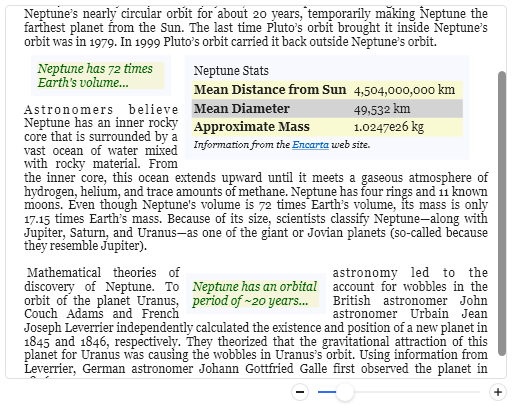1
2
3
4
5
6
7
8
9
10
11
12
13
14
15
16
17
18
19
20
21
22
23
24
25
26
27
28
29
30
31
32
33
34
35
36
37
38
39
40
41
42
43
44
45
46
47
48
49
50
51
52
53
54
55
56
57
58
59
60
61
62
63
64
65
66
67
68
69
70
71
72
73
74
75
76
77
78
79
80
81
82
83
84
85
86
87
88
89
90
91
92
93
| <FlowDocumentScrollViewer IsToolBarVisible="True" Width="502" Height="400" Margin="32">
<FlowDocument ColumnWidth="400" IsOptimalParagraphEnabled="True" IsHyphenationEnabled="True">
<Section FontSize="12">
<Paragraph>
<Bold>Neptune</Bold> (planet), major planet in the solar system, eighth planet
from the Sun and fourth largest in diameter. Neptune maintains an almost constant
distance, about 4,490 million km (about 2,790 million mi), from the Sun. Neptune
revolves outside the orbit of Uranus and for most of its orbit moves inside the
elliptical path of the outermost planet Pluto (see Solar System). Every 248 years,
Pluto’s elliptical orbit brings the planet inside Neptune’s nearly circular orbit
for about 20 years, temporarily making Neptune the farthest planet from the Sun.
The last time Pluto’s orbit brought it inside Neptune’s orbit was in 1979. In
1999 Pluto’s orbit carried it back outside Neptune’s orbit.
<Figure Width="140" Height="50" Background="GhostWhite" HorizontalAnchor="PageLeft" HorizontalOffset="100" VerticalOffset="20">
<Paragraph FontStyle="Italic" TextAlignment="Left" Background="Beige" Foreground="DarkGreen">
Neptune has 72 times Earth's volume...
</Paragraph>
</Figure>
<Floater Background="GhostWhite" Width="285" HorizontalAlignment="Left">
<Table CellSpacing="5">
<Table.Columns>
<TableColumn Width="155"/>
<TableColumn Width="130"/>
</Table.Columns>
<TableRowGroup>
<TableRow>
<TableCell ColumnSpan="3">
<Paragraph>Neptune Stats</Paragraph>
</TableCell>
</TableRow>
<TableRow Background="LightGoldenrodYellow" FontSize="12">
<TableCell>
<Paragraph FontWeight="Bold">Mean Distance from Sun</Paragraph>
</TableCell>
<TableCell>
<Paragraph>4,504,000,000 km</Paragraph>
</TableCell>
</TableRow>
<TableRow FontSize="12" Background="LightGray">
<TableCell>
<Paragraph FontWeight="Bold">Mean Diameter</Paragraph>
</TableCell>
<TableCell>
<Paragraph>49,532 km</Paragraph>
</TableCell>
</TableRow>
<TableRow Background="LightGoldenrodYellow" FontSize="12">
<TableCell>
<Paragraph FontWeight="Bold">Approximate Mass</Paragraph>
</TableCell>
<TableCell>
<Paragraph>1.0247e26 kg</Paragraph>
</TableCell>
</TableRow>
<TableRow>
<TableCell ColumnSpan="4">
<Paragraph FontSize="10" FontStyle="Italic">
Information from the
<Hyperlink NavigateUri="http://encarta.msn.com/encnet/refpages/artcenter.aspx">Encarta</Hyperlink>
web site.
</Paragraph>
</TableCell>
</TableRow>
</TableRowGroup>
</Table>
</Floater>
</Paragraph>
<Paragraph>
Astronomers believe Neptune has an inner rocky core that is surrounded by a vast
ocean of water mixed with rocky material. From the inner core, this ocean extends
upward until it meets a gaseous atmosphere of hydrogen, helium, and trace amounts
of methane. Neptune has four rings and 11 known moons. Even though Neptune's volume
is 72 times Earth’s volume, its mass is only 17.15 times Earth’s mass. Because of
its size, scientists classify Neptune—along with Jupiter, Saturn, and Uranus—as
one of the giant or Jovian planets (so-called because they resemble Jupiter).
</Paragraph>
<Paragraph>
<Figure Width="140" Height="50" Background="GhostWhite" TextAlignment="Left" HorizontalAnchor="PageCenter" WrapDirection="Both">
<Paragraph FontStyle="Italic" Background="Beige" Foreground="DarkGreen" >
Neptune has an orbital period of ~20 years...
</Paragraph>
</Figure>
Mathematical theories of astronomy led to the discovery of Neptune. To account for
wobbles in the orbit of the planet Uranus, British astronomer John Couch Adams and
French astronomer Urbain Jean Joseph Leverrier independently calculated the existence
and position of a new planet in 1845 and 1846, respectively. They theorized that the
gravitational attraction of this planet for Uranus was causing the wobbles in Uranus’s
orbit. Using information from Leverrier, German astronomer Johann Gottfried Galle first
observed the planet in 1846.
</Paragraph>
</Section>
</FlowDocument>
</FlowDocumentScrollViewer>
|
